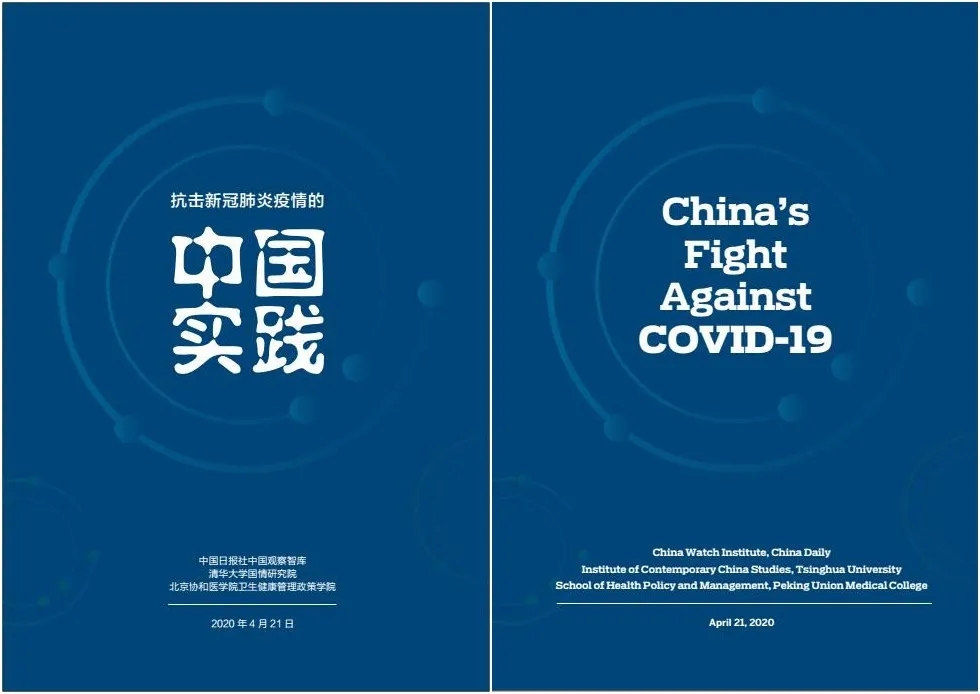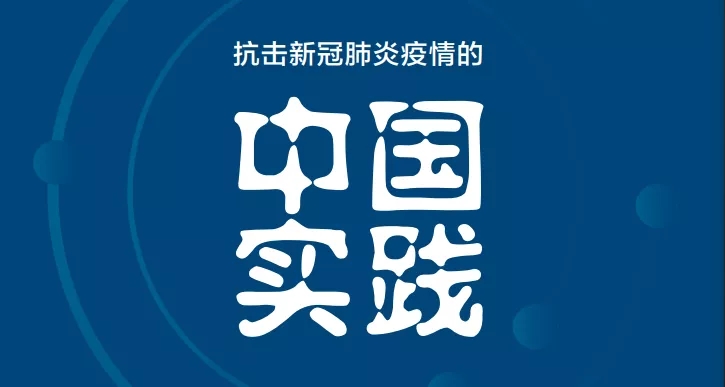重磅!中英文双语《抗击新冠肺炎疫情的中国实践》报告发布【附关键词盘点】
“抗击新冠病毒的中国方案”主题网站21日发布《抗击新冠肺炎疫情的中国实践》中英双语报告,初步总结梳理过去一段时间中国抗击疫情的举措和方法,以期与国际社会携手应对共同威胁和挑战,共同维护全球公共卫生安全。

▲ 报告中英文封面(图片来源:中国日报网报告截图)
该报告由中国日报社中国观察智库在采访征询60余位公共卫生专家和中外学者意见的基础上,联合清华大学国情研究院、北京协和医学院卫生健康管理政策学院共同完成。
报告分为社会共识和全民动员、社会隔离和交通管控、排查检测和动态监测、诊疗方案和救治能力、资源调配和物资保障、指挥体系和战略方针六个部分,总结了中国抗击疫情的具体实践,梳理了中国采取的公共卫生应对措施,以及在阻断病毒传播方面的做法,希望能为国际科学界和国际社会共同抗击新冠疫情提供参考借鉴。
The report, "China's Fight Against COVID-19", features six chapters with topics ranging from social mobilization to treatment plans. It was compiled in collaboration with the Institute of Contemporary China Studies at Tsinghua University and the School of Health Policy and Management at Peking Union Medical College.
Experts said the report can help readers understand the rationale behind many of China's decisions, practices and sacrifices. This will, in turn, help reduce uninformed speculation about China's actions including a city-wide quarantine and revision of death counts.
报告客观呈现了中国政府和人民面对疫情的应对举措。日本立命馆大学政策科学部教授周玮生表示,中国如果不采取封城措施,其感染人数有可能超过现在的10倍,在没有新冠病毒有效预防手段和治疗技术的时候,坚决并尽快切断感染源是首要措施。
Zhou Weisheng, a professor with the College of Policy Science at Ritsumeikan University in Japan, said if China had not imposed the lockdown on Wuhan and some other cities, the number of infections might have been 10 times higher.
"Considering the lack of effective treatment methods for COVID-19, cutting off the source of infection by locking down Wuhan and some other cities as soon as possible was the right measure," he said.
联合课题组表示,这个报告通过广泛收集征询专家学者意见,基于权威文献资料梳理,由媒体联合科研机构进行共同研究,以调研报告的形式讲述“中国抗击疫情故事”,但随着疫情形势变化和抗疫工作进展,尚需不断更新充实完善。作为较早总结中国抗击新冠肺炎疫情实践的一次尝试,希望起到“抛砖引玉”之效,以尊重科学、遵从规律、尊崇实践的精神,不断总结好人类战胜重大传染性疾病的经验。
这次疫情的发生再次表明,人类是一个休戚与共的命运共同体。在国务院新闻办公室的支持下,中国日报于上月推出 “抗击新冠病毒的中国方案”英文主题网站,该网站由国家卫生健康委员会、科学技术部、国家药品监督管理局和国家中医药管理局共同指导。上线后,引起舆论高度关注,特别是海外读者对网站分享的科普知识、治疗方案和社会动员举措等中国做法给予了高度评价。
(图片来源: “抗击新冠病毒的中国方案”英文主题网站截图)
英文版报告还摘取了一些关键词与大家分享↓
信息发布机制
Information release mechanism
Information, including daily updates of confirmed cases, suspected cases and response policies, has been revealed to the public in a timely, transparent and accurate manner through various means such as press conferences held by the State Council Information Office, the Joint Prevention and Control Mechanism of the State Council and local governments.
避免污名化
Avoid stigmatization
Viruses are a common challenge faced by the entire human race. The novel coronavirus was named SARS-CoV-2 and the relevant disease was named as COVID-19 according to international guidelines of avoiding association between viruses or infectious diseases with any geographic locations, cultures or groups of people.
社区疫情防控
Community-based epidemic prevention and control
Communities are on the front lines in prevention and control of the epidemic. Empowering communities to implement prevention and control measures is key to victory over COVID-19.
《中国-世界卫生组织新型冠状病毒肺炎联合考察报告》
Report of the WHO-China Joint Mission on COVID-19
Twenty-five experts from eight countries and the World Health Organization started a nine-day mission in China on Feb 16. On Feb 29, the team released a report, which concluded China has rolled out "perhaps the most ambitious, agile and aggressive disease containment effort in history".
封城
Lockdown of a city
Since there are not yet vaccines or targeted medications for the novel coronavirus, the lockdown of a region might be the most efficient way to prevent the virus from spreading.
高、中、低风险地区
High-, medium- and low-risk areas
Cities, counties and districts with no active cases or with no new infections in the past 14 days are categorized as low-risk regions; those with new infections in the past 14 days and fewer than 50 cumulative confirmed cases, or with over 50 cumulative confirmed cases but without a concentrated outbreak in the past 14 days are categorized as medium-risk regions; those with over 50 cumulative confirmed cases and a concentrated outbreak in the past 14 days are categorized as high-risk regions.

(图片来源:中国日报网报告截图)
自我隔离
Self-quarantine
Since the outbreak, Chinese people have carried out self-quarantine, cut non-essential travel and stayed at home as much as possible to prevent cross-infection. Close contacts of confirmed cases should observe strict centralized quarantine or home quarantine for at least 14 days to see if there is any infection.
保持社交距离
Social distancing
In public places, people should keep about 2 meters away from each other to protect themselves from possible infection. People are encouraged to wear a mask in public and avoid crowds or meal gatherings.
健康码
Health QR code
Based on information people voluntarily offer, a mobile app could generate a health QR code with different colors: Green code means little chance of having been infected, while holders of yellow and red codes must be put under quarantine for a few days and report their health information daily before they are cleared for travel again. The health QR code system was first adopted in Hangzhou city of Zhejiang province, and then expanded to other Chinese cities.
应收尽收、应治尽治
Admitting all suspected and confirmed cases for treatment
President Xi Jinping stressed that all-out efforts should be made to admit all suspected and confirmed cases for treatment, raise the hospital admission rate and the recovery rate, and lower the infection rate and the fatality rate.
集中拉网式排查
Massive screening of potential virus carriers
With the principle of saving every life, community-based screening was carried out in key regions such as Wuhan to identify all confirmed infections, suspected cases and close contacts. Patients and people at high risk would be sent to proper medical institutions for timely treatment and to reduce the risk of further spread of the virus.
流行病学调查
Epidemiological investigation
Epidemiological investigations are key to identifying chain of epidemic transmission, which is the basis of defining close contacts, adopting appropriate isolation measures and defining the sterilization scope.
健康申报
Declaration of health information
Inbound passengers flying from high-risk regions to the Chinese mainland are required to submit their health information truthfully.
无症状感染者
Asymptomatic patients
People who display no relevant symptoms such as fever, cough or sore throat, but test positive for the novel coronavirus. A very small number of asymptomatic cases develop into confirmed infections, but most recover on their own.
早发现、早报告、早隔离、早治疗
Early detection, early reporting, early isolation and early diagnosis
The four principles proven to be best practices in China's fight against the COVID-19.
医防结合
Emphasis is needed on both prevention and treatment
Equal importance should be attached to prevention and treatment. The prevention and control system at the community level should also be enhanced.
中西医并用
Combined use of traditional Chinese medicine (TCM) and western medicine
Clinical treatment found the combined use of traditional Chinese medicine and western medicine can relieve fever, cough, fatigue and other symptoms, shorten hospitalization days and reduce the rate of deterioration.
方舱医院
Fangcang shelter hospitals
Also known as mobile cabin hospitals. Under the principle of leaving no one untreated, sports stadiums and convention centers were quickly converted to mobile cabin hospitals to treat patients with mild symptoms.
心理疏导
Psychological counseling
Care for the psychological wellbeing of COVID-19 patients, their families, families of fallen patients, vulnerable groups, health workers and those fighting the virus on the front line, including police officers and community workers.
在线诊疗
Online diagnosis and treatment
About 200 public hospitals and 100 online hospitals provide online diagnosis and treatment guidance to mitigate pressure on hospitals which have a large number of inpatients.
坚持全国一盘棋
Ensure a coordinated national response
Ensuring the whole country works together is key to stimulate enthusiasm and mobilize resources for fighting COVID-19. Under the leadership of the Communist Party of China, various regions and departments in China are able to efficiently carry out decisions made by the central government and synchronize policies and mobilize resources to form a united force to fight the epidemic.
对口支援
Pairing assistance
A Chinese practice under which a specific province or major city provides assistance to a designated region in need of help. In the novel coronavirus outbreak, 19 provincial-level regions were paired with 16 cities in Hubei excluding Wuhan to offer dedicated point-to-point help to fight COVID-19. For Wuhan, resources were mobilized from across the country to help the city battle the epidemic.
重大突发公共卫生事件一级响应
First-level public health emergency response
Since the epidemic outbreak, all 31 provincial-level regions on the Chinese mainland initiated a first-level response to the public health emergency, the highest in the four-level public health emergencies classification.
来源:中国日报双语新闻微信公众号、中国日报网,译世界编辑整理,转载请注明来源!




